4-Butoxybenzenesulfonyl chloride
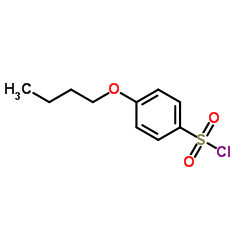
4-Butoxybenzenesulfonyl chloride structure
|
Common Name | 4-Butoxybenzenesulfonyl chloride | ||
|---|---|---|---|---|
| CAS Number | 1138-56-3 | Molecular Weight | 248.726 | |
| Density | 1.2±0.1 g/cm3 | Boiling Point | 354.0±15.0 °C at 760 mmHg | |
| Molecular Formula | C10H13ClO3S | Melting Point | 19 °C | |
| MSDS | N/A | Flash Point | 167.9±20.4 °C | |
| Name | 4-butoxybenzenesulfonyl chloride |
|---|---|
| Synonym | More Synonyms |
| Density | 1.2±0.1 g/cm3 |
|---|---|
| Boiling Point | 354.0±15.0 °C at 760 mmHg |
| Melting Point | 19 °C |
| Molecular Formula | C10H13ClO3S |
| Molecular Weight | 248.726 |
| Flash Point | 167.9±20.4 °C |
| Exact Mass | 248.027390 |
| PSA | 51.75000 |
| LogP | 4.10 |
| Vapour Pressure | 0.0±0.8 mmHg at 25°C |
| Index of Refraction | 1.520 |
| InChIKey | HGKWMUBXVMFXNC-UHFFFAOYSA-N |
| SMILES | CCCCOc1ccc(S(=O)(=O)Cl)cc1 |
Synonym: Section 2 - COMPOSITION, INFORMATION ON INGREDIENTS
Risk Phrases: 34 Section 3 - HAZARDS IDENTIFICATION EMERGENCY OVERVIEW
Causes burns.Moisture sensitive. Potential Health Effects Eye: Causes eye burns. Skin: Causes skin burns. Ingestion: Causes gastrointestinal tract burns. Inhalation: Causes chemical burns to the respiratory tract. Chronic: Not available. Section 4 - FIRST AID MEASURES Eyes: Immediately flush eyes with plenty of water for at least 15 minutes, occasionally lifting the upper and lower eyelids. Get medical aid immediately. Skin: Get medical aid immediately. Immediately flush skin with plenty of water for at least 15 minutes while removing contaminated clothing and shoes. Ingestion: Do not induce vomiting. Get medical aid immediately. Inhalation: Get medical aid immediately. Remove from exposure and move to fresh air immediately. If not breathing, give artificial respiration. If breathing is difficult, give oxygen. Notes to Physician: Treat symptomatically and supportively. Section 5 - FIRE FIGHTING MEASURES General Information: As in any fire, wear a self-contained breathing apparatus in pressure-demand, MSHA/NIOSH (approved or equivalent), and full protective gear. Extinguishing Media: Use foam, dry chemical, or carbon dioxide. Section 6 - ACCIDENTAL RELEASE MEASURES General Information: Use proper personal protective equipment as indicated in Section 8. Spills/Leaks: Absorb spill with inert material (e.g. vermiculite, sand or earth), then place in suitable container. Section 7 - HANDLING and STORAGE Handling: Do not breathe dust, vapor, mist, or gas. Do not get in eyes, on skin, or on clothing. Use only in a chemical fume hood. Storage: Store in a cool, dry place. Store in a tightly closed container. Corrosives area. Store under nitrogen. Section 8 - EXPOSURE CONTROLS, PERSONAL PROTECTION Engineering Controls: Facilities storing or utilizing this material should be equipped with an eyewash facility and a safety shower. Use adequate ventilation to keep airborne concentrations low. Exposure Limits CAS# 1138-56-3: Personal Protective Equipment Eyes: Not available. Skin: Wear appropriate protective gloves to prevent skin exposure. Clothing: Wear appropriate protective clothing to prevent skin exposure. Respirators: Follow the OSHA respirator regulations found in 29 CFR 1910.134 or European Standard EN 149. Use a NIOSH/MSHA or European Standard EN 149 approved respirator if exposure limits are exceeded or if irritation or other symptoms are experienced. Section 9 - PHYSICAL AND CHEMICAL PROPERTIES Physical State: Liquid Color: Not available. Odor: Not available. pH: Not available. Vapor Pressure: Not available. Viscosity: Not available. Boiling Point: 130 - 132 deg C @0.6mmHg Freezing/Melting Point: Not available. Autoignition Temperature: Not available. Flash Point: Not available. Explosion Limits, lower: Not available. Explosion Limits, upper: Not available. Decomposition Temperature: Solubility in water: Specific Gravity/Density: Molecular Formula: C10H13ClO3S Molecular Weight: 249 Section 10 - STABILITY AND REACTIVITY Chemical Stability: Not available. Conditions to Avoid: Incompatible materials, exposure to moist air or water. Incompatibilities with Other Materials: Strong oxidizing agents, bases. Hazardous Decomposition Products: Hydrogen chloride, chlorine, carbon monoxide, oxides of sulfur, carbon dioxide. Hazardous Polymerization: Has not been reported Section 11 - TOXICOLOGICAL INFORMATION RTECS#: CAS# 1138-56-3 unlisted. LD50/LC50: Not available. Carcinogenicity: 4-Butoxybenzene-1-sulfonyl chloride - Not listed by ACGIH, IARC, or NTP. Section 12 - ECOLOGICAL INFORMATION Section 13 - DISPOSAL CONSIDERATIONS Dispose of in a manner consistent with federal, state, and local regulations. Section 14 - TRANSPORT INFORMATION IATA Shipping Name: CORROSIVE LIQUID, ACIDIC, ORGANIC, N.O.S.* Hazard Class: 8 UN Number: 3265 Packing Group: III IMO Shipping Name: CORROSIVE LIQUID, ACIDIC, ORGANIC, N.O.S. Hazard Class: 8 UN Number: 3265 Packing Group: III RID/ADR Shipping Name: CORROSIVE LIQUID, ACIDIC, ORGANIC, N.O.S. Hazard Class: 8 UN Number: 3265 Packing group: III Section 15 - REGULATORY INFORMATION European/International Regulations European Labeling in Accordance with EC Directives Hazard Symbols: C Risk Phrases: R 34 Causes burns. Safety Phrases: S 26 In case of contact with eyes, rinse immediately with plenty of water and seek medical advice. S 36/37/39 Wear suitable protective clothing, gloves and eye/face protection. S 45 In case of accident or if you feel unwell, seek medical advice immediately (show the label where possible). WGK (Water Danger/Protection) CAS# 1138-56-3: No information available. Canada None of the chemicals in this product are listed on the DSL/NDSL list. CAS# 1138-56-3 is not listed on Canada's Ingredient Disclosure List. US FEDERAL TSCA CAS# 1138-56-3 is not listed on the TSCA inventory. It is for research and development use only. SECTION 16 - ADDITIONAL INFORMATION N/A |
| Hazard Codes | C:Corrosive; |
|---|---|
| Risk Phrases | R34 |
| Safety Phrases | S26-S36/37/39 |
| RIDADR | 3265 |
| Packaging Group | III |
| Hazard Class | 8 |
| HS Code | 2909309090 |
|
~61% 
4-Butoxybenzene... CAS#:1138-56-3 |
| Literature: Guo, Xiaoke; Yang, Qian; Xu, Jing; Zhang, Li; Chu, Hongxi; Yu, Peng; Zhu, Yingying; Wei, Jinglian; Chen, Weilin; Zhang, Yaozhong; Zhang, Xiaojin; Sun, Haopeng; Tang, Yiqun; You, Qidong Bioorganic and Medicinal Chemistry, 2013 , vol. 21, # 21 p. 6466 - 6476 |
|
~44% 
4-Butoxybenzene... CAS#:1138-56-3 |
| Literature: LEAD Therapeutics, Inc. Patent: US2010/105607 A1, 2010 ; US 20100105607 A1 |
|
~% 
4-Butoxybenzene... CAS#:1138-56-3 |
| Literature: Bulletin de la Societe Chimique de France, , p. 248 - 250 |
|
~% 
4-Butoxybenzene... CAS#:1138-56-3 |
| Literature: Bioorganic and Medicinal Chemistry, , vol. 21, # 21 p. 6466 - 6476 |
| HS Code | 2909309090 |
|---|---|
| Summary | 2909309090 other aromatic ethers and their halogenated, sulphonated, nitrated or nitrosated derivatives VAT:17.0% Tax rebate rate:9.0% Supervision conditions:none MFN tariff:5.5% General tariff:30.0% |
| para-n-butoxyphenylsulfonyl chloride |
| 4-Butoxybenzenesulfonyl chloride |
| p-n-butoxybenzenesulfonyl chloride |
| 4-(n-butoxy)-benzenesulfonyl chloride |
| Benzenesulfonyl chloride, 4-butoxy- |
| 4-butoxybenzene-1-sulfonyl chloride |
| MFCD00052344 |
| 4-Butoxybenzenesulfonylchloride |
| 4-(n-butoxy)-phenylsulfonyl chloride |
| 4-(N-butoxy)benzenesulphonyl chloride |
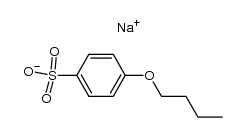

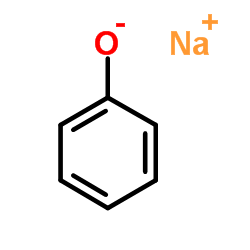

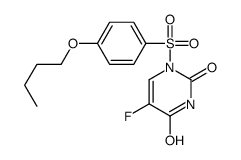 CAS#:105411-89-0
CAS#:105411-89-0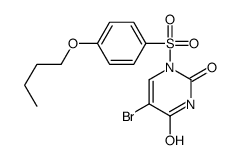 CAS#:105411-94-7
CAS#:105411-94-7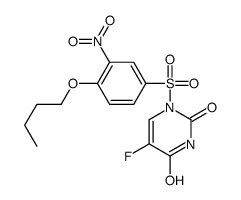 CAS#:128887-36-5
CAS#:128887-36-5 CAS#:1138-58-5
CAS#:1138-58-5